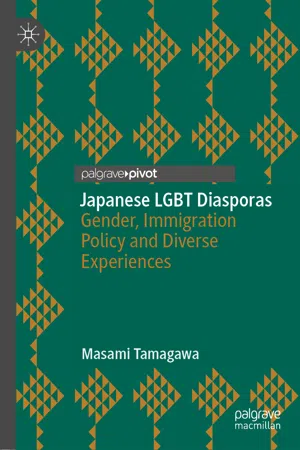Abstract
After discussing Japanese immigration histories and statistics to the USA, Canada, and Australia, as a background, the introductory chapter surveys the conditions of LGBT individuals in contemporary Japanese culture and society, including some popular notions, such as “gay-friendly Japan,” the difficulty of coming out of the closet, the lack of legal protection of LGBT individuals and couples at the national level, as well as gender inequalities in employment and sexuality. Also, a number of publications concerning LGBT refugees and immigration are examined and some of the major objectives of the present project are discussed. In addition, the chapter discusses methodology, including the online survey the author conducted in the summer of 2018, including the categories of questions, languages used, closed-end, and open-ended questions. While taking the online questionnaire, participants often noted comments and explanations. Also, about half of the participants volunteered to participate in a follow-up study and the majority of them enthusiastically shared their experiences and thoughts. Their narratives serve as a valuable source of information for an ethnographic analysis of their experiences. Additionally, the chapter offers statistics on the participants (N = 55), including their nationalities, linguistic diversity, sexuality, gender identity, and the average number of years overseas, as well as some of the major characteristic of select participants (N = 35).
Introduction
While empirical studies on LGBT refugees from Muslim countries are common, these studies are rare from Northeast Asian countries. Through a close examination of the data collected from an online survey, as well as follow-up responses, this study explores the lives of Japanese LGBT individuals in the USA, Canada, and Australia and seeks to find some of the major reasons they have left Japan , their present situations, needs, and future plans. The findings from the three different countries will be comparatively examined. Also, the findings from this project will be compared with the findings from previous studies on LGBT refugees and carefully examined to identify some of the major similarities as well as differences between Japanese LGBT immigrants and LGBT refugees.
A refugee from Japan may sound an oxymoron; however, the findings will attest, although Japan does not have a sodomy law , LGBT experiences in Japan are not any better. Japanese society seems to “tolerate” ( kanyō ) its queer members, as long as they stay in their place on the society’s margin, Japanese LGBT individuals typically experience an overt, direct rejection, including homophobia , when they come out to their parents. Due to their social marginalization as well as rejection by their parents, Japanese LGBT individuals suffer greatly and have some profound reasons to leave the country.
Once in the USA, Canada, or Australia, Japanese LGBT diasporas continue to have some major difficulties, due, for example, to immigration issues , cultural differences, and a language barrier , among others. Further, the findings attest that migration to these countries is a gendered experience and that gay men, and possibly bisexual men, seem to have some critical advantages over the others at multiple points in Japan as well as abroad in their course of migration. Moreover, immigration as well as LGBT policies in their host countries play major roles in their experiences abroad. In conclusion, I will address their special needs among Japanese LGBT diasporas , highlighting suggestions and recommendations for lawmaker and activists, and propose social services aimed at them.
History of Japanese Migration Prior to World War II
In Japanese history, a little over a million people have migrated overseas. Apart from a few diplomats, travelers, and the like, the majority of them have left the country over the last 150 years, notably, approximately 800,000 people from the mid-nineteenth century to the outbreak of World War II (JICA 1994). In the beginning, Japanese migrants were bound for Hawaii and the American West Coast , the two most popular destinations, as well as Canada’s Vancouver Island and Broome in Western Australia, to a lesser extent, seeking a better opportunity in the New World . The great majority of them were farmers and predominantly male. Japanese migrants initially arrived in the New World in the 1860s and 1870s (Daniels 2006; Sissons 1972; Stanlaw 2006).
Hawaii and the American West Coast
In 1868, the first year of the Meiji period, a shipment of 141 men, six women, and a child arrived in Hawaii , marking the beginning of Japanese emigration. They were under three-year contracts; yet, the majority remained, thus becoming the founders of the Japanese community in the islands. For the next 16 years, however, the Meiji government prohibited contract labor emigration, in order to evade the horrors of and the stigma attached to the coolie trade, as experienced by their Chinese counterparts (Daniels 2006, 30–31). In 1885, as discussed below, due mostly to some domestic problems, contract labor migration continued, and more than 30,000 Japanese came to Hawaiian plantations before 1895, when it was ended.
Since then, Japanese migrants continued to arrive in Hawaii , this time as free agents. Overall, some 180,000 Japanese had migrated to Hawaii by 1924. At the same time, it is believed that many of them were eying the American West Coast as their final destination. The annexation of Hawaii in 1898 facilitated their movement to the US mainland and some 40,000 of them made their secondary migration to the US mainland by early 1908 (Daniels 2006, 31). One of the major pull factors for the USA was a growing demand for cheap labor to replace Chinese immigrants after the enactment of the Chinese Exclusion Act of 1882, which resulted from fear of the so-called Yellow Peril , a growing anxiety over cheap Chinese labor (Chan 1991, 55). Additionally, beside the Japanese immigrants in Hawaii who made their secondary migration the American West Coast , there were a small group of political exiles from Japan who founded an agricultural colony at Gold Hill in California , as early as, 1868. According to the census, there were 148 Japanese, the great m...
